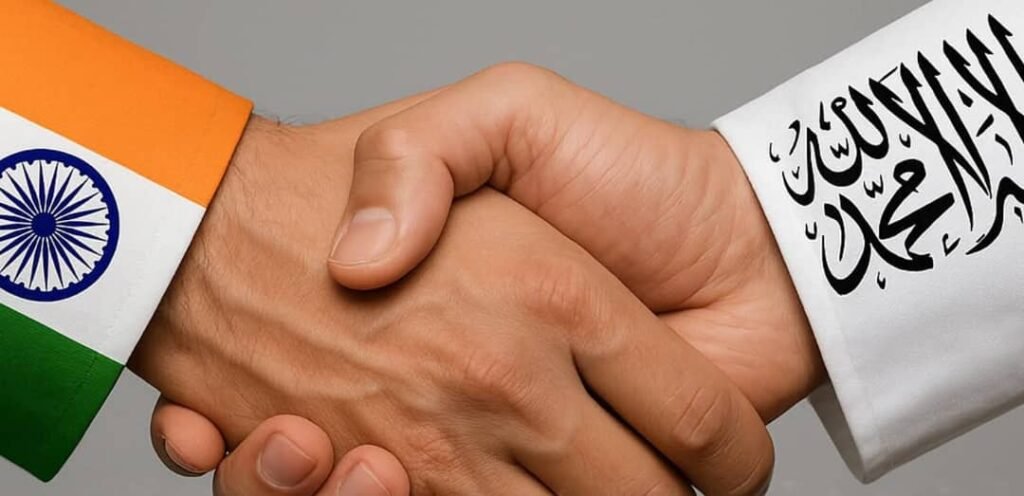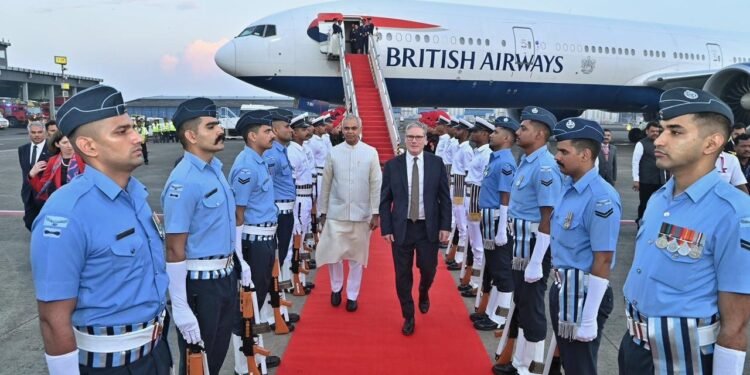MUMBAI/ NEW DELHI: India has entered a rare diplomatic moment where commerce and calculus converge on a single stage. In the space of days, New Delhi has hosted Britain’s Prime Minister Keir Starmer, leading a business-heavy trade mission that pressed for rapid implementation of the newly signed UK-India free trade agreement, and readied itself to receive Afghan Taliban foreign minister Mawlawi Amir Khan Muttaqi. The pairing of a high-value Western economic push and a politically fraught outreach to Kabul says as much about India’s ambitions as it does about the constraints of a newly multipolar era.
Starmer’s public message was unambiguous: the UK wants the deal operational “as soon as humanly possible,” and he arrived with an unusually large delegation of corporate leaders to push the point. For Britain, the pact is part of a post-Brexit growth strategy to anchor trade with dynamic Asian markets; for India, it is an opportunity to lock in market access, investment, and technology transfers while projecting itself as a dependable partner to the Global North. The trade agreement concluded after years of negotiation is projected to increase bilateral trade by roughly £25.5 billion in the long run and to deliver measurable boosts to GDP and wages on the UK side, figures that explain both the urgency and the political theater accompanying the visit.
The optics of business were deliberate: CEOs and executives from sectors ranging from aerospace and energy to digital services accompanied Starmer, signalling that the deal’s beneficiaries will include high-value manufacturing, green energy, and services as much as traditional exports. That delegation strength and proposals such as expanded air links is meant to convert a headline FTA into real, on-the-ground commerce and investment flows. But translating a signed text into jobs, factories, and export orders will demand bureaucratic speed, regulatory alignment and patient political management in both capitals.
Running in parallel is a different diplomatic logic. The Taliban’s Amir Khan Muttaqi has arrived in New Delhi on a UN-exempted trip that marks the first high-level Taliban visit to India since 2021. New Delhi has not recognized the Taliban as a legitimate government, yet it has steadily preserved pragmatic channels, a limited technical mission in Kabul, humanitarian engagement, and episodic contacts aimed at securing India’s strategic and economic interests in Afghanistan. Inviting Muttaqi reflects a sober calculation: engaging a government that controls Afghanistan is necessary to protect cross-border security, to safeguard supply routes and projects of interest, and to maintain leverage over outcomes that affect India’s neighborhood.
Viewed together, the two moves crystallize India’s doctrine of strategic autonomy. New Delhi seeks to maximize commercial openings with Western partners while retaining the diplomatic flexibility to talk to uneasy neighbors. This posture has immediate upsides: the trade deal can accelerate industrialization, raise export competitiveness, and deepen technology partnerships; engagement with Kabul can open modest trade corridors, help monitor extremist threats, and preserve Indian soft-power footholds in Afghanistan. But the gains are conditional and constrained by implementation frictions, geopolitical blowback, and reputational costs.
Economically, the UK FTA is a lever for supply-chain reorientation. India can use tariff liberalization and services commitments to attract higher-value manufacturing and digital investments that Europe previously hesitated to place in the region. SMEs and exporters can benefit from tariff savings and streamlined rules of origin, but only if customs, standards convergence, and logistics bottlenecks are fixed rapidly. The danger is that headline projections (billions in trade uplift) become political alibis if companies encounter regulatory delay, uneven market access, or domestic protectionist pushback.
Politically, Starmer’s urgency is also domestically motivated. For a UK government seeking growth narratives after Brexit, quick wins with India matter. That political imperative will push for rapid ratification and operationalization, potentially compressing timelines that normally require phased implementation and domestic stakeholder consultations. India must therefore balance the need for speed with the need to protect sensitive sectors and manage public opinion, especially among constituencies fearful of import competition in agriculture, dairy and low-end manufacturing.
Engagement with the Taliban is even more fraught. Hosting Muttaqi, made possible by a temporary UN travel exemption, gives India a vantage point inside Afghan affairs without diplomatic recognition. That channel could help India press for counter-terrorism assurances, protect its projects (notably through Iran’s Chabahar corridor), and keep India-Afghanistan trade alive for goods such as dry fruits and pharmaceuticals. Yet the move risks criticism from rights groups and Western partners alarmed by the Taliban’s record on women’s rights and civil liberties. India must therefore frame its engagement narrowly: transactional, conditional, and tied to clear benchmarks on security cooperation and humanitarian access.

Geopolitically, Delhi’s double posture will be interpreted across capitals. Pakistan and China will watch the Kabul outreach closely, assessing whether India will regain influence in Afghanistan or merely provide a public relations platform for the Taliban. Washington, which remains a security partner but also a critic of Taliban policies, will parse India’s calibrated engagement to determine whether it undermines broader counter-terrorism norms or complements pragmatic regional stabilization. For Europe and the UK, India’s ability to host a Western trade partner while quietly dealing with difficult regional actors signals its emergence as a pivot, but it also forces partners to accept the messiness of real-world diplomacy. This is the new geopolitics: influence accrues not to purity of alliances but to the ability to manage multiple relationships simultaneously.
Several hard realities will decide whether this week becomes a turning point or a footnote. First, implementation. The FTA must clear domestic procedures, align regulatory frameworks, and create predictable dispute-resolution pathways. Without a credible, phased implementation plan and visible early wins (investment announcements, tariff reductions going live, customs efficiencies), the political momentum in both capitals will fade. Second, sequencing and optics. India’s government must sequence its diplomatic messages so that trade celebrations are not eclipsed by backlash over Afghan engagement; transparency about the narrow, security-focused goals of Muttaqi’s visit can blunt criticism. Third, delivery on the ground. For both deals and diplomacy, Delhi must convert promises into tangible outcomes: flights scheduled and launched, investments announced and green-lit, humanitarian flows secured, and counter-terrorism assurances tested. Failure to produce visible deliverables will weaken India’s bargaining power faster than any rhetorical applause.
Finally, there is a normative question that will shadow these tactical moves. Can a rising power be both a partner for open markets and a pragmatic interlocutor with actors of questionable legitimacy without eroding the moral capital that soft power requires? India’s answer will shape how democracies and developing countries view engagement with states that do not meet liberal standards but still matter strategically.
Policy-wise, New Delhi should pursue three simultaneous tracks. One, accelerate a transparent, phased implementation roadmap for the UK FTA that assigns milestones, removes predictable bottlenecks, and pairs liberalization with compensatory support for vulnerable domestic sectors. Two, condition engagement with Kabul on measurable security and humanitarian benchmarks, while insulating civil society and human rights channels from diplomatic sidelining. Three, use the diplomatic bandwidth created by both visits to deepen regional economic linkages – Chabahar, Central Asian connectivity projects, and the International Solar Alliance leadership, so that India’s diplomacy is not episodic but cumulative.
This week is a test of dexterity: can India turn high-level maneuvers into durable advantage without tripping over politics at home or scrutiny abroad? If New Delhi executes well, it will show that strategic autonomy is not a posture of isolation but a capability to shape outcomes across trade and security simultaneously. If it stumbles, the same moves that raised applause will be reinterpreted as overreach or incoherence.
India’s choices in the coming months will define not just the fate of a trade deal or a diplomatic visit but a model for how rising powers operate in a fractured world: trading access with the West while talking to awkward neighbors, converting commercial opportunity into geopolitical resilience, and negotiating the moral margins of engagement. In short, this week may be less a moment than a map, a sketch of the routes through which India intends to travel as it writes the rules of its own ascent.
— Dr. M Shahid Siddiqui I Follow via X @shahidsiddiqui
PLEASE SUBSCRIBE CHANNEL FOR EXCLUSIVE TALKS



















